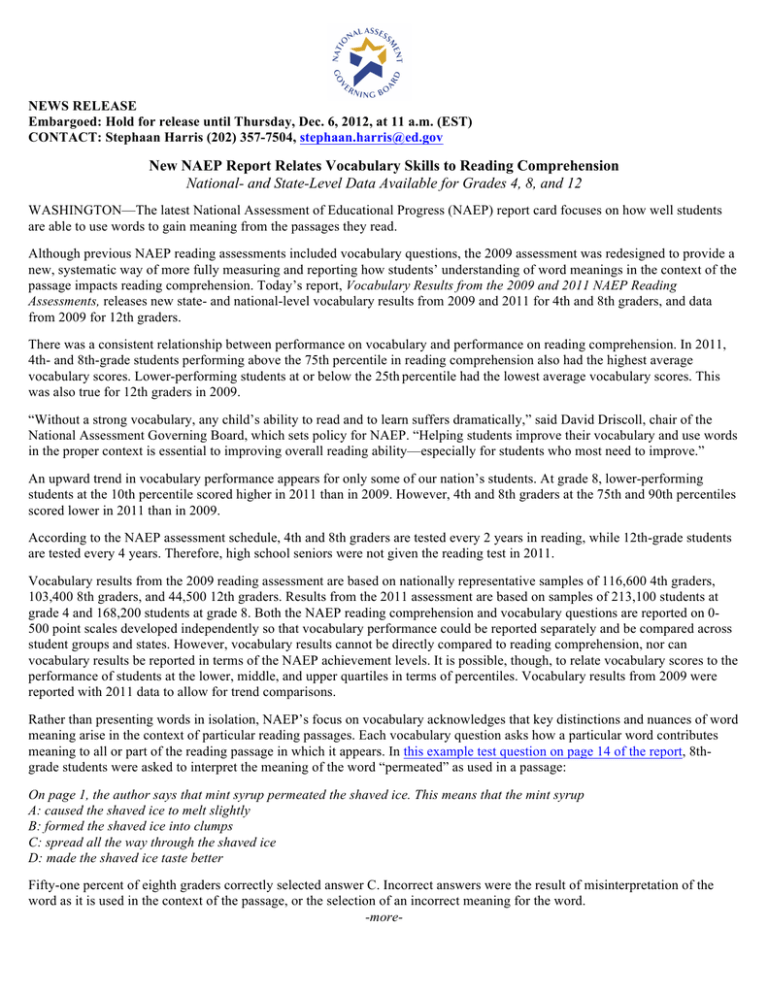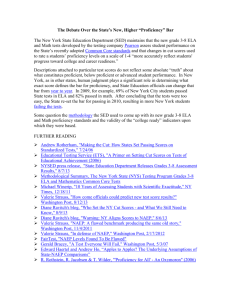Document 10699662
advertisement

NEWS RELEASE Embargoed: Hold for release until Thursday, Dec. 6, 2012, at 11 a.m. (EST) CONTACT: Stephaan Harris (202) 357-7504, stephaan.harris@ed.gov New NAEP Report Relates Vocabulary Skills to Reading Comprehension National- and State-Level Data Available for Grades 4, 8, and 12 WASHINGTON—The latest National Assessment of Educational Progress (NAEP) report card focuses on how well students are able to use words to gain meaning from the passages they read. Although previous NAEP reading assessments included vocabulary questions, the 2009 assessment was redesigned to provide a new, systematic way of more fully measuring and reporting how students’ understanding of word meanings in the context of the passage impacts reading comprehension. Today’s report, Vocabulary Results from the 2009 and 2011 NAEP Reading Assessments, releases new state- and national-level vocabulary results from 2009 and 2011 for 4th and 8th graders, and data from 2009 for 12th graders. There was a consistent relationship between performance on vocabulary and performance on reading comprehension. In 2011, 4th- and 8th-grade students performing above the 75th percentile in reading comprehension also had the highest average vocabulary scores. Lower-performing students at or below the 25th percentile had the lowest average vocabulary scores. This was also true for 12th graders in 2009. “Without a strong vocabulary, any child’s ability to read and to learn suffers dramatically,” said David Driscoll, chair of the National Assessment Governing Board, which sets policy for NAEP. “Helping students improve their vocabulary and use words in the proper context is essential to improving overall reading ability—especially for students who most need to improve.” An upward trend in vocabulary performance appears for only some of our nation’s students. At grade 8, lower-performing students at the 10th percentile scored higher in 2011 than in 2009. However, 4th and 8th graders at the 75th and 90th percentiles scored lower in 2011 than in 2009. According to the NAEP assessment schedule, 4th and 8th graders are tested every 2 years in reading, while 12th-grade students are tested every 4 years. Therefore, high school seniors were not given the reading test in 2011. Vocabulary results from the 2009 reading assessment are based on nationally representative samples of 116,600 4th graders, 103,400 8th graders, and 44,500 12th graders. Results from the 2011 assessment are based on samples of 213,100 students at grade 4 and 168,200 students at grade 8. Both the NAEP reading comprehension and vocabulary questions are reported on 0500 point scales developed independently so that vocabulary performance could be reported separately and be compared across student groups and states. However, vocabulary results cannot be directly compared to reading comprehension, nor can vocabulary results be reported in terms of the NAEP achievement levels. It is possible, though, to relate vocabulary scores to the performance of students at the lower, middle, and upper quartiles in terms of percentiles. Vocabulary results from 2009 were reported with 2011 data to allow for trend comparisons. Rather than presenting words in isolation, NAEP’s focus on vocabulary acknowledges that key distinctions and nuances of word meaning arise in the context of particular reading passages. Each vocabulary question asks how a particular word contributes meaning to all or part of the reading passage in which it appears. In this example test question on page 14 of the report, 8thgrade students were asked to interpret the meaning of the word “permeated” as used in a passage: On page 1, the author says that mint syrup permeated the shaved ice. This means that the mint syrup A: caused the shaved ice to melt slightly B: formed the shaved ice into clumps C: spread all the way through the shaved ice D: made the shaved ice taste better Fifty-one percent of eighth graders correctly selected answer C. Incorrect answers were the result of misinterpretation of the word as it is used in the context of the passage, or the selection of an incorrect meaning for the word. -more- A variety of words were selected from texts of varying difficulty at each grade level. Another sample question involved a grade 12 NAEP reading passage in which Bill Gates argues that human beings must embrace the digital age. Students were asked what the author was suggesting when he says that we can “mitigate” the challenges of the digital age; 50 percent of 12th graders selected the correct interpretation of the word. Vocabulary performance varied by gender, racial and ethnic background, and family income level. Nationally, females scored higher on average than males at grades 4 and 8 in 2011; however, a gender gap was not observed at grade 12 in 2009. This national pattern was not reflected in all states; 30 states had no significant gender gap at grades 4 and 8. Data on race and ethnicity show that average vocabulary scores for white and Asian/Pacific Islander students were higher than the scores for black, Hispanic, and American Indian/Alaska Native students. In grades 4 and 8, students from lower-income families scored lower than students from higher-income families. “Persistent achievement gaps between students of different racial, ethnic, and socio-economic backgrounds need to be a focus of improvement for educators, policymakers and the public,” Driscoll said. “There is still a great deal of work that needs to be done to enhance the vocabulary understanding, and reading ability, of all students.” State-level vocabulary scores from 2011 are available for all 50 states, the District of Columbia, and Department of Defense Education Activity (DoDEA) schools for grades 4 and 8. Average scores were higher than the national average in 4th and 8th grades in 18 states/jurisdictions: Colorado, Connecticut, Idaho, Kansas, Kentucky, Maryland, Massachusetts, Minnesota, Montana, Nebraska, New Hampshire, New Jersey, North Dakota, Ohio, Pennsylvania, Utah, Virginia, and DoDEA. Additional Highlights: Grade 4 Pennsylvania was the only state in which students scored higher in 2011 than they did in 2009. Students in most states scored the same in both years, but the average 2011 score in Arkansas, Indiana, and Iowa was lower than in 2009. Thirty-three percent of students scoring below the 25th percentile were white, 25 percent were black, and 35 were Hispanic. Of students scoring above the 75th percentile, 72 percent were white, 7 percent were black, and 10 percent were Hispanic. Grade 8 Score gaps between white and Hispanic students narrowed from 30 points to 28 points from 2009 to 2011, and this narrowing was observed at the 10th and 25th percentiles. English language learners in the 25th and 50th percentiles scored higher in 2011 than in 2009. Grade 12 In 6 of the 11 states that participated in 2009, average scores were not statistically different from the nation, but in 2 states, Arkansas and Florida, average scores were lower. Forty percent of students scoring below the 25th percentile were white, 26 percent were black, and 27 percent were Hispanic. Of students scoring above the 75th percentile, 79 percent were white, 7 percent were Hispanic, and 5 percent were black. In 2009, average 12th-grade scores were higher than the nation in 3 of the 11 states participating: Connecticut, Massachusetts, and New Hampshire. Vocabulary Results from the 2009 and 2011 NAEP Reading Assessments is available at www.nationsreportcard.gov. Visit www.nagb.org/vocabulary-2009-2011 for more information and materials on recent results. ### The Nation’s Report Card is the largest nationally representative, continuing evaluation of the condition of education in the United States and has served as a national yardstick of student achievement since 1969. Through the National Assessment of Educational Progress (NAEP), The Nation’s Report Card informs the public about what America’s students know and can do in various subject areas, and compares achievement data among states and various student demographic groups. The National Assessment Governing Board is an independent, bipartisan board whose members include governors, state legislators, local and state school officials, educators, business representatives and members of the general public. Congress created the 26-member Governing Board in 1988 to set policy for NAEP.



